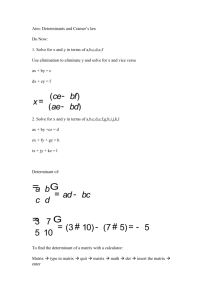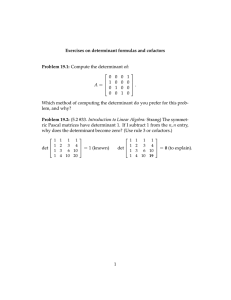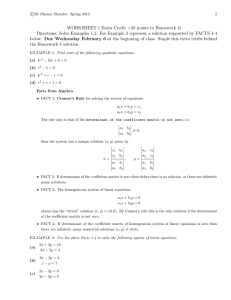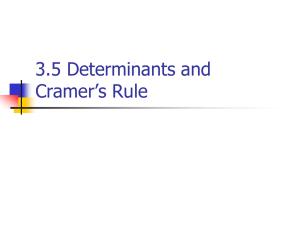EE 210 Fall 2011 Simultaneous Linear Equations Dr. Blandford
advertisement
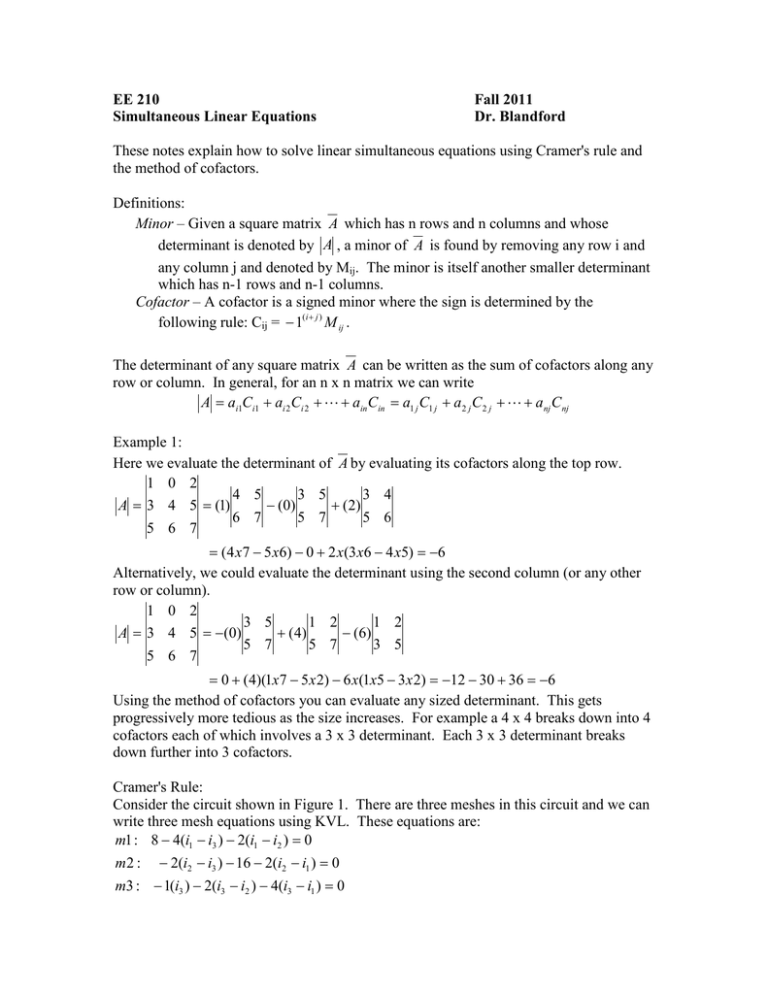
EE 210 Simultaneous Linear Equations Fall 2011 Dr. Blandford These notes explain how to solve linear simultaneous equations using Cramer's rule and the method of cofactors. Definitions: Minor – Given a square matrix A which has n rows and n columns and whose determinant is denoted by A , a minor of A is found by removing any row i and any column j and denoted by Mij. The minor is itself another smaller determinant which has n-1 rows and n-1 columns. Cofactor – A cofactor is a signed minor where the sign is determined by the following rule: Cij = − 1(i + j ) M ij . The determinant of any square matrix A can be written as the sum of cofactors along any row or column. In general, for an n x n matrix we can write A = ai1Ci1 + ai 2Ci 2 + + ain Cin = a1 j C1 j + a2 j C 2 j + + anj C nj Example 1: Here we evaluate the determinant of A by evaluating its cofactors along the top row. 1 0 2 4 5 3 5 3 4 + (2) A = 3 4 5 = (1) − (0) 6 7 5 7 5 6 5 6 7 = (4 x7 − 5 x6) − 0 + 2 x(3 x6 − 4 x5) = −6 Alternatively, we could evaluate the determinant using the second column (or any other row or column). 1 0 2 1 2 1 2 3 5 A = 3 4 5 = −(0) + ( 4) − (6) 5 7 3 5 5 7 5 6 7 = 0 + (4)(1x7 − 5 x 2) − 6 x(1x5 − 3 x 2) = −12 − 30 + 36 = −6 Using the method of cofactors you can evaluate any sized determinant. This gets progressively more tedious as the size increases. For example a 4 x 4 breaks down into 4 cofactors each of which involves a 3 x 3 determinant. Each 3 x 3 determinant breaks down further into 3 cofactors. Cramer's Rule: Consider the circuit shown in Figure 1. There are three meshes in this circuit and we can write three mesh equations using KVL. These equations are: m1 : 8 − 4(i1 − i3 ) − 2(i1 − i2 ) = 0 m2 : − 2(i2 − i3 ) − 16 − 2(i2 − i1 ) = 0 m3 : − 1(i3 ) − 2(i3 − i2 ) − 4(i3 − i1 ) = 0 Figure 1 Using nodal analysis we get three equations with three unknowns. In matrix form these equations become the following: m1 : − 6i1 + 2i2 + 4i3 = −8 4 i1 − 8 − 6 2 or 2 − 4 2 ⋅ i2 = 16 m2 : 2i1 − 4i2 + 2i3 = 16 4 2 − 7 i3 0 m3 : 4i1 + 2i2 − 7i3 = 0 three new matrices by removing one column of the A matrix and replacing that column with the b matrix. Doing this leads to the following equations: 4 − 8 2 − 6 2 − 8 − 6 − 8 4 Ai1 = 16 − 4 2 Ai 3 = 2 − 4 16 Ai 2 = 2 16 2 0 4 4 2 − 7 0 − 7 2 0 Cramer's 1 rule states that we can find the values of the unknowns i1, i2, and i3 from the following equations: A A A i3 = i3 i1 = i1 i2 = i 2 A A A We can evaluate the required determinants using cofactors. In each case we will choose a row or column that contains zeros to minimize the multiplications of the cofactors. Ai1 = −8 −4 2 2 4 − 16 + 0 = −8(24) − 16(−22) = 160 2 −7 2 −7 Ai 2 = −(−8) 1 2 2 −6 4 + 16 − 0 = 8(−22) + 16(26) = 240 4 −7 4 −7 Cramer's rule and the method of cofactors is derived in many books. For example see Ayres, Frank, Jr., Theory and Problems of Matrices, Schaum's Outline Series, McGraw-Hill, 1962. Ai 3 = −8 A = −6 2 −4 −6 2 − 16 + 0 = −8(20) − 16(−20) = 160 4 2 4 2 −4 2 2 4 2 4 −2 +4 = −6(24) − 2(−22) + 4(20) = −20 2 −7 2 −7 −4 2 These determinant values give i1 = 160 / − 20 = −8 i2 = 240 / − 20 = −12 i3 = 160 / − 20 = −8
